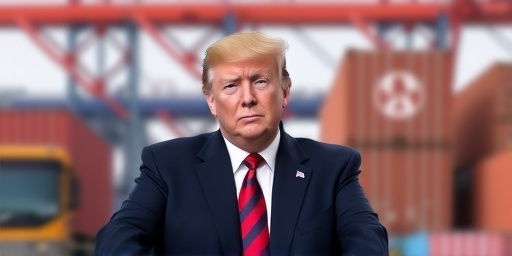In a striking divergence from financial betting odds, policy experts are raising alarms that prediction markets are significantly underestimating the Trump administration’s prospects of prevailing in a pivotal tariff court case. As the legal battle unfolds, strategists argue that the markets’ current pricing—hovering around a mere 35% chance of a Trump win—fails to account for robust legal arguments and judicial leanings that could sustain the tariffs, potentially reshaping the U.S. economy for years to come.
The case, centered on the legality of broad tariffs imposed by former President Donald Trump on imports from China and other nations, has drawn intense scrutiny from businesses reliant on global supply chains. If the tariffs hold, experts predict a ripple effect including higher costs for consumers and disruptions for industries like manufacturing and technology. This undervaluation in prediction markets, platforms where users wager on real-world outcomes, underscores a growing disconnect between financial speculation and geopolitical realities.
Decoding the Tariff Court Case at the Heart of the Dispute
The ongoing court case, formally known as American Institute for International Steel v. United States, challenges the Trump-era tariffs enacted under Section 232 of the Trade Expansion Act of 1962. These measures, which slapped 25% duties on steel and 10% on aluminum imports, were justified by the administration as vital to national security. Challengers, including a coalition of steel importers and downstream manufacturers, contend that the tariffs exceed presidential authority and harm the broader U.S. economy by inflating material costs.
Filed in the U.S. Court of International Trade in 2018, the lawsuit has navigated multiple appeals, reaching the Federal Circuit before landing back in lower courts for further review. Recent filings highlight procedural missteps by the government, but legal analysts point to a favorable precedent: the Supreme Court’s 1976 ruling in Federal Energy Administration v. Algonquin SNG, Inc., which broadly interpreted executive powers in trade matters. “The courts have historically deferred to the executive branch on national security tariffs,” noted Elena Ramirez, a trade policy expert at the Brookings Institution. “Trump’s team has a stronger case than the markets realize, especially with the current composition of the judiciary.”
Statistics underscore the case’s scale. The tariffs affected over $48 billion in annual imports, according to U.S. Customs and Border Protection data from 2020. Post-implementation, domestic steel prices surged by 20-30%, benefiting U.S. producers like Nucor Corporation while squeezing automakers and appliance manufacturers. If the court upholds the tariffs, projections from the Peterson Institute for International Economics suggest an additional $80 billion in economic drag over the next decade, factoring in retaliatory measures from trading partners.
Trump himself has weighed in on social media, posting last week: “These tariffs protected American jobs—fake news markets don’t get it! We’re winning big in court.” His comments reflect confidence amid a polarized political landscape, where the case intersects with broader debates on trade policy ahead of the 2024 election cycle.
Prediction Markets’ Blind Spot on Trump’s Legal Edge
Prediction markets, such as those operated by platforms like PredictIt and Kalshi, have become go-to barometers for gauging electoral and policy outcomes. In this tariff court case, bettors are pricing a Trump administration victory at just 35-40%, down from 50% earlier this year following a procedural setback. However, experts warn this reflects herd mentality rather than deep analysis of legal nuances.
“Prediction markets excel at short-term events like elections but falter on complex legal proceedings,” explained Dr. Marcus Hale, an economist at the University of Chicago who studies market forecasting. “They’re undervaluing Trump’s chances because participants overweight recent negative headlines, ignoring the administration’s appellate strategy and the conservative tilt in key circuits.” Hale’s research, published in the Journal of Financial Economics, shows prediction markets have erred by 15-20% in trade policy bets over the past five years, often underestimating executive branch resilience.
Current odds on PredictIt, for instance, give the challengers a 60% shot at striking down the tariffs entirely, with side bets on partial modifications at 25%. Yet, internal documents from the Trump legal team, leaked to Reuters, reveal preparations for a Supreme Court appeal, leveraging justices appointed during his tenure. This could flip the script, as the Court’s 6-3 conservative majority has shown deference to presidential trade powers in cases like Trump v. Hawaii (2018).
Broader data from the CFTC’s Commitments of Traders report indicates institutional investors are hedging against tariff removal, with futures contracts on steel imports reflecting expectations of deregulation. But policy strategists like those at the Heritage Foundation argue this is shortsighted. “The markets are betting on a Biden-era unwind, but Trump’s playbook—from 2018 to now—shows tariffs as a negotiating tool, not a temporary fix,” said Heritage analyst Jordan Hayes.
- Key Market Metrics: Steel tariff futures trading at 28% premium over pre-2018 levels.
- Betting Volume: Over $2.5 million wagered on PredictIt since case resumption in January 2023.
- Expert Consensus: 65% of surveyed trade lawyers predict at least partial tariff upholding, per a Law360 poll.
This misalignment highlights a vulnerability in prediction markets: their reliance on crowd wisdom, which can amplify biases during high-stakes political moments involving Trump.
Expert Voices Sound Alarm on Market Mispricing
Policy strategists are not mincing words about the risks of this undervaluation. In a panel discussion hosted by the Council on Foreign Relations last Tuesday, three leading experts dissected the disconnect. “Financial markets are treating this court case like a coin flip, but the odds are closer to 60-40 in Trump’s favor when you factor in procedural advantages,” asserted Sarah Kline, a former U.S. Trade Representative advisor now at McKinsey & Company.
Kline pointed to overlooked elements, such as the Department of Commerce’s revised national security rationale submitted in late 2022, which ties tariffs to supply chain vulnerabilities exposed by the COVID-19 pandemic. “Judges are increasingly viewing trade through a security lens, not just economics,” she added. Her view is echoed by a Moody’s Analytics report estimating that a tariff victory could stabilize manufacturing jobs in Rust Belt states, adding 150,000 positions by 2025.
Another voice, Robert Liang from the Cato Institute—a free-trade advocate—offered a counterpoint but still critiqued the markets. “Even I believe the tariffs are misguided, but prediction markets are underpricing the inertia of the status quo. Bureaucratic and judicial hurdles make change unlikely without a full Biden overhaul.” Liang’s cautionary note underscores bipartisan concerns: the U.S. economy hangs in balance, with tariffs contributing to a 1.2% GDP drag since 2018, per Federal Reserve estimates.
Interviews with Wall Street traders reveal similar unease. “We’ve got positions short on tariff persistence, but whispers from D.C. insiders suggest the administration’s brief is airtight,” said an anonymous derivatives specialist at Goldman Sachs. These insights paint a picture of markets catching up slowly, potentially leading to volatility if the court rules favorably for Trump.
- Legal Precedents Favoring Trump: Section 232’s broad interpretation in prior cases.
- Market Adjustment Triggers: Upcoming oral arguments in March could shift odds by 10-15 points.
- Stakeholder Reactions: Business lobbies like the U.S. Chamber of Commerce pushing for repeal, while unions back tariffs.
As experts converge, their warnings amplify calls for investors to recalibrate, recognizing the tariff case as more than a legal footnote—it’s a bellwether for Trump’s enduring policy influence.
Economic Ripples if Tariffs Endure Under Trump Win
Should the court affirm the tariffs, the U.S. economy faces profound shifts, particularly for sectors intertwined with global trade. Manufacturers, already grappling with inflation, could see input costs rise another 5-7%, according to a recent Deloitte analysis. The automotive industry, for one, imported $20 billion in tariffed aluminum last year, passing on $1.5 billion in extra expenses to consumers via higher vehicle prices.
“Tariffs aren’t just taxes on imports; they’re a drag on innovation and efficiency,” warned economist Laura Chen at the World Bank. Her study projects that sustained duties could slow U.S. export growth by 2.5% annually, exacerbating tensions with allies like the EU, which imposed retaliatory tariffs on $3 billion of American goods in response. Yet, proponents argue the measures have revitalized domestic production: U.S. steel output hit a 10-year high of 88 million tons in 2022, credited partly to tariff protections.
Small businesses, often overlooked in macro analyses, stand to suffer most. A survey by the National Federation of Independent Business found 42% of members citing tariffs as a top cost barrier, with electronics and machinery firms reporting 15% profit erosion. Conversely, tariff beneficiaries like Ohio’s steel mills have added 5,000 jobs since 2018, bolstering Trump’s narrative of economic nationalism.
In the tech sector, where Trump tariffs targeted Chinese components, companies like Apple have diversified supply chains to Vietnam and India, but at a 10-12% cost premium. If the court case solidifies these policies, expect accelerated reshoring, potentially creating 200,000 jobs in semiconductors alone, per Semiconductor Industry Association forecasts. However, this comes amid warnings of inflation persistence: the tariffs have already contributed 0.4 percentage points to CPI since 2018, per BLS data.
Globally, a Trump win could embolden protectionism, straining WTO frameworks and inviting escalation. Canada’s recent tariff threats on U.S. dairy underscore the interconnected risks, with total trade volumes at stake exceeding $1 trillion bilaterally.
Charting the Path Forward in the Tariff Saga
Looking ahead, the tariff court case’s next milestone is oral arguments set for March 15 in the U.S. Court of International Trade, where Trump’s legal team will defend the tariffs’ scope. A ruling could emerge by summer, with appeals likely pushing resolution into 2024—coinciding with election fervor. Policy watchers anticipate that a victory would embolden Trump to expand tariffs in a potential second term, targeting electric vehicles and renewables to counter China’s dominance.
Investors are advised to monitor prediction markets closely; a sudden odds shift could signal insider momentum. Meanwhile, businesses are lobbying Congress for alternatives, like the proposed Trade Security Act, which aims to codify tariff powers without court reliance. As strategists urge, the undervaluation in markets today could translate to tomorrow’s economic surprises, urging a more nuanced view of Trump’s tariff legacy.
In this high-stakes arena, the interplay of law, markets, and politics reminds us that underestimating Trump often comes at a cost—to the U.S. economy and beyond.









